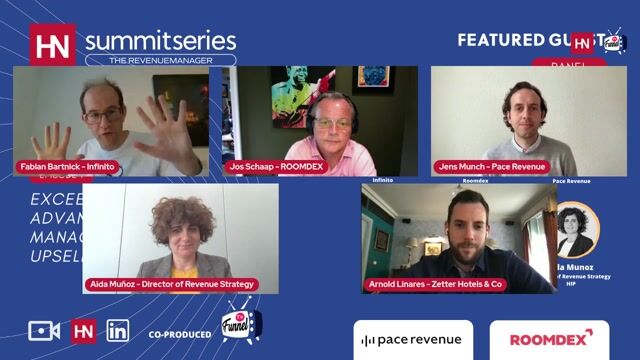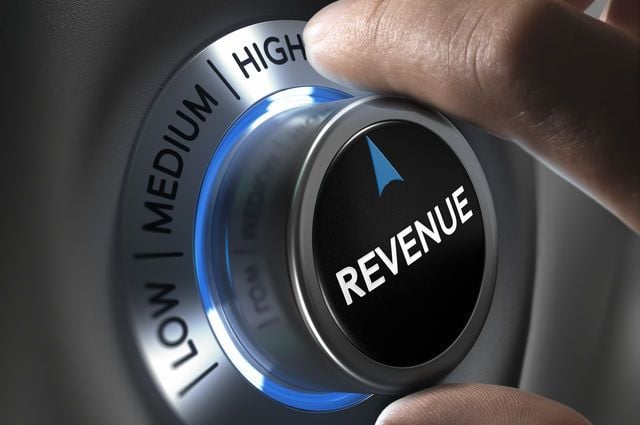Should hotels look to diversify their income streams now?
15 experts shared their view
Expedia Group CEO Peter Kern believes that 2023 will be the year that we stop predicting a travel recovery and actually start enjoying it. In an interview with Bloomberg, he said further: "Summer 2022 will be the busiest travel season ever." But after two years of little to no demand, many hoteliers have started to look beyond traditional room revenue and warmed up to the opportunity which lies in non-room revenue. With a possible record summer ahead, will the idea of total revenue (and total revenue management) remain a focus for the industry or will we revert back to business as (pre-pandemic) usual? So the question is: Should hotels look to diversify their income streams and when is this the right time to do so? What should hoteliers be looking out for in the process and where is the opportunity?
This World Panel Viewpoint is sponsored by:

FLYR (formerly Pace Revenue)
More information

The right time to diversify income streams was yesterday - or even better - years before the pandemic! I certainly hope that the momentum and creativity around figuring out every angle on generating revenue from the hotel asset persists. The challenge, of course, is that the opportunity will be different for every hotel type, hotel company and hotel location, so the teams on the ground need to get creative, and the owners need to be prepared to invest. We seem to have convinced ourselves as an industry that total hotel revenue management means simultaneously optimizing every revenue stream at the hotel, or applying revenue management theory to every outlet and ancillary stream at the property. Unfortunately, both of these definitions imply that this only works if you have a myriad of revenue generating outlets like F&B, meeting space, spa, retail etc etc., leaving out a large percentage of hotels.
To be successful in this area, every hotel team should think about products and services that their particular guest segments need/want and would value, and then figure out how their asset, regardless of its composition, could deliver them. This will be about flexible use of the space (can you monitize the lobby, the outdoor space, the pool?), and creative partnerships (tours, room add ons, transportation). Most importantly, it will require that all team members at the hotel from commercial to operations to finance, are aligned in building a revenue culture, and thinking creatively together about both opportunities, and the effort it will take to execute them.
I was discussing with a colleague the other day, and he said something that deeply resonated with me: "In hospitality, like in any other industry, there's no such thing as ancillary sources of revenue. If you're selling a service or a product, that's revenue, period." I think this is an excellent way of putting it, as it's undeniable that our industry is traditionally room-centric when it comes to revenue management. However, I always felt this approach was myopic, at best.
A study by CarTrawler highlighted how a company such as Wizz Air made 55.9% of its 2021 total revenue thanks to what we call "ancillary revenue." So, if an ultra-low-cost carrier makes more money on "Classic Mature Cheddar and Onion Relish Sandwich" than on the actual flights, what does that say about our industry?
My two cents is that revenue per square meter (or total revenue management, call it what you like) is the only possible revenue management. I mean: when you buy a pair of sneakers, do you consider laces to be ancillary? If you do, you're probably a revenue manager...
During pandemic we have seen an increase in package and leisure sales, especially for the non-central hotels. With travelers willing to spend more money on theirselves many hotels have seen an increase in incremental revenue. We see an increase in requests for Total Revenue Management projects now that restrictions are lifted and demand is returning. So, I think that my reply would be; Yes, hotels should look to diversify their income streams. Especially if they want to keep market share.
The right time for hotels to start looking to diversify their income streams was undoubtedly yesterday. We have been talking about total revenue management and ancillary revenue for years and we have seen the focus on extra revenue changing post-pandemic, with a retail sale approach developing. Right now, travel is coming back and the big risk for those that haven't broadened their view so far is to be attracted by the main revenue stream (rooms) only, neglecting all the other opportunities for extra income that are there.
In a moment when there is very little price resistance and the customer is open to experiencing travel at its fullest after 2 years of constraints, we must acknowledge that a Hotel is an asset with different revenue streams that are meant to be managed. It is s not just about being ready for a plan B as we learned that the unexpected can happen, it is about creating a revenue culture that involves and empowers all the different departments, making everyone accountable for getting the most out of the potential there is to attract demand and generate revenue opportunities for the whole asset's profits.
More than asking if hotels should diversify their revenue streams now, they should be asked what has stopped them doing so earlier!, or in other words, why do hotels only do revenue management in the space where there is a bed? Total Revenue Manager must be the focus of every hotel nowadays = focus on the revenue per square metre, ask yourself "Am I maximizing this space/corner/garden/parking?" if the answer is no, it's time to roll up your sleves!
The most important move is to fully open the property to non-residents. Except some all-inclusive resorts, almost every other hotel can do that: Offers to locals to enjoy the bar/restaurant, day passes for the Spa/pool, renting the parking spaces to neighbouring businesses... all in all, making sure the local community is aware of all the Hotel has to offer.
Going one step forward, the Hotel can consider renting spaces to local businesses: be it a meeting space for a local company (co-working space), the ballroom to the local martial arts club or yoga studio, or a Lobby corner to a craftsman/barber/deli barista, etc...for a pop up concept.
It's never too late to try new ways of generating extra revenue, and the sooner Hotels try, the earlier they will find out what works and what doesn't, getting ahead of the curve and being able to maximize the revenue generated by each square metre of the property.
I am a firm believer that a hotel is more than a place for providing temporary sleeping quarters. In the post-pandemic era, it is time to analyze, identify, diversify and maximize the revenue opportunities and adopt a total revenue management strategy and culture at the property.
To begin with, any hotel has numerous untapped, quite often significant revenue opportunities from:
- Core "hotel" ancillary products
- “Non-hotel" ancillary revenues
- Underutilized hotel spaces
- Creating Airbnb-type of product
Why the airlines are a good example to follow?
Hoteliers need to study and copy the airlines' mastery for generating ancillary revenues "out of thin air": in 2019 the airlines' ancillary revenue grew to $64.8 billion from $28.5 billion in 2014. Some airlines like Allegiant Airlines in Las Vegas, Nevada generate as high as 40% of their total revenue from auxiliaries.
How many hoteliers can boast a similar percentage of non-room and non-F&B revenues? How many hotels can boast that 15%, 25% or 35% of their revenue comes from the sale of non-core and ancillary products like this is the case with a typical airline? A hotel has significantly greater ancillary and non-room revenue opportunities than the airlines, yet very few hotels take full advantage of these bottom line enhancing ancillary products.
Why is that? One of the reasons is that many hoteliers are struggling to create the internal processes and systems to successfully sell non-room and ancillary services.
Example: In 2019, the last “normal” year before the pandemic, out of 700 hotels in New York City, only a half dozen offered Broadway theater packages. Why? Too much work, disincentivized employees, and lack of merchandizing strategy.
Generating non-core and ancillary revenues requires a) the implementation of merchandizing strategy and culture at the property/hotel company, b) incentivizing and training your staff, and c) adopting technology solutions to automate as many of the internal processes as possible.
Let's review some of the opportunities hoteliers have to diversify their property revenue:
1. Core Hotel Ancillary Products:
Upsells:
These products are primarily around upselling, upgrading and cross-selling the property's core amenities: better rooms, suites, spa services, F&B (Interested in our Caribbean Buffet tonight?), early check-ins, late check-outs, etc.
Implementing automated solutions like ROOMDEX and Oracle's Nor1 can dramatically increase ancillary revenues, reduce labor cost and enable your staff to focus on delivering exceptional guest services. Another benefit of using technology is that you can upsell during the booking process on your website or call center, via reservation confirmations, during the mobile check-in, and yes, at the front desk or via the self check-in kiosk.
Room self-selection:
For decades now you have been able to select your airline seats, movie theater or opera seats via digital floor plans. I have asked for 20 years now: Why not select your hotel room in advance? Now you can!
Hilton was the first major hotel chain to introduce its Room Selection Capability across its North American properties. Offered exclusive to the Hilton Honors program, members can check-in the day before arrival and select their rooms from a digital floor plan. Members can customize their stay by purchasing a room upgrade (if available) and requesting specific amenities to be delivered to their room before arrival.
Room self-selection offers immense merchandising opportunities: Look for PMS or third-party applications that allow your guests to self-select their room during the mobile or self check-in process from a digital floor plan of your property. The new Oracle Hospitality Integration Hub already offers a similar partner application. Now a similar service is offered to independent hotels by Expect Me, a Belgium-based startup.
Travel consumers are already accustomed to choosing online airline seats, movie theater seats, opera seats, etc., why not hotel rooms? This can be a great way to generate additional revenue: You want a room away from the elevator? It's $10 more. A room on a higher floor? $20 more. Upgrade to a suite for $50? I am convinced room selection will become the norm within the next few years. Enabling advance room selection and mobile keys ad part of mobile and contactless check-in is a great way for reducing your front desk staffing needs by half.
2. Non-Core Hotel Ancillary Products:
Here the sky is the limit! I see two great merchandizing opportunities and here are just a few of them:
- Sale of guest stay-enhancing ancillary products like champagne for special occasions, romantic stay decorations, chocolate covered strawberries, ice cream, bouquet of flowers, breakfast in bed, etc.
- Sale of city passes and tickets to local museums, theme parks, sporting events, concerts and performances, art exhibitions and other attractions, as well as sightseeing tours to places of interest. Better off, selling hotel packages including these local attractions and activities would not only “hide” the room price, but will allow the hotel to sell on value vs sell on rate alone.
3. Maximize Utilization of Hotel Spaces
I see several additional and significant revenue generation initiatives for the utilization of the underutilized hotel spaces:
- Create co-working spaces: Similar to Roger Smith Hotel's KettleSpace Flexible Workspaces, create work-from-hotel spaces for out-of-towners, digital nomads and local entrepreneurs who do not want to be tied down by office leases. Create Room and Office daily, weekly and monthly packages and promotions, including WiFi, coffee, bottled water, snacks and catered lunch.
- Create F&B revenue opportunities in empty and underutilized spaces by installing vending machines, pizza or burger robots. These robots can provide tremendous revenue opportunities for budget, economy and midscale properties without F&B or replace struggling restaurants at upper midscale and other 3- and 4-star properties.
- Vending Machines: We will be witnessing a real resurrection of the vending machine serving breakfast, snacks, hot and cold drinks, naturally in a much more sophisticated reiteration. Marriott is already testing giant vending machines it calls “grab-and-go marketplaces” that can dispense everything from coffee to breakfast sandwiches and cereal.
- Creator, San Francisco's automated burger restaurant, features a 14-foot burger machine with more than 350 sensors that is capable of making 130 premium quality custom burgers an hour, plus a window for takeout orders.
- Piestro, an innovative robotic pizza shop, can deliver high-quality artisanal pizzas within 3 minutes. Their fully-automated machines are being designed with the aim of allowing for zero contact food preparation, zero food waste, consistent quality, and a much lower cost of operation.
- Utilize unused conference/function space: With the corporate group and netting's markets ramping up with a slower pace than leisure travel, utilize unused fu cation space to offer yoga classes, wellness programs, cooking classes, new book readings and author signing events, neighborhood craft shows, etc.
4. Create “Airbnb-type” of product
Short-terms rentals increased their market share during the pandemic and now constitute almost one third of reservations for accommodations in your area. Hoteliers must understand that short-term rental players like AirBnB, Vrbo, Vacasa, etc. are direct competitors and are diverting away at least a portion of their potential guests.
What should hoteliers do?
- Start by monitoring closely Airbnb's, Vrbo's and other vacation rental properties in your market. Research and identify the rental properties in your neighborhood, and what are their typical amenities and features. Ask your BI rate shopping tech vendor to add shirt-term rentals to the set of competitors your are monitoring on a daily basis.
- Identify your property's value proposition and create a list of all of your property's amenities, services and attributes that, in your view, are better than the average vacation rental in your area. Then review and update the property descriptions on the hotel website, social media profiles, CRS and WBE descriptions, directory listings, Google Business Profile, and promotional materials.
- Create a short-term rental type of a hotel product: Introduce weekly and monthly rates for suites with kitchenettes, adjacent rooms to appeal to family travelers; rooms with use of a community kitchen, washers and dryers.
- How many hotels offer rates for extended stays or family stays which are favored by travel consumers in the current environment? Remember, a weekly rate is NOT a daily rate multiplied by seven. A monthly rate is NOT a nightly rate multiplied by 30! Make sure that your CRS, WBE (Website Booking Engine) and Channel Manager can support weekly and monthly rates and fire them if they can't.
- Make sure to educate your staff about the key advantages your property has over the vacation rentals in the area: from better location to no cleaning fees to better cleanliness protocols and really high-speed Wi-Fi and free breakfast.
The moral of the story? Hire and train employees who do not think that diversifying your property revenue is too much work, and you take it from there.
Total hotel revenue optimization should be on everyone's agenda. What that means for individual hotels is different depending on the type of hotel. Perhaps we should reframe the questions slightly and ask the question: should we be more focused on total profit optimization? This concept naturally takes into account all revenue streams and in particular how can we best optimize profit in each and ensure we attract the right customers that will contribute to greater profit.
Diversifying revenue streams and Total Revenue Management are two separate things. Hotels have always had diversified revenue streams, but we also need to face reality that many hotels have little extras they can offer beyond the usual. That doesn't mean things cannot be done, but the input output ratio mostly falls flat on its face. This has always been the case and we should give hotels credit for that.
Total revenue management on the other hand is still a big question mark. We are not only lacking skills in revenue management per se + on top of it, hotels are not adopting RM. It is a great concept and if the data is interlinked and set up for it, a great place to be in. For those who have it - go for it! But for the moment, most of the industry sits in siloes and it is much more preferential to look at each of the siloes and optimize each part.
My recommendation: Focus on your biggest revenue generators and optimize there. If you are unsure, get someone in to look at your data, your set up, give you a helping hand so YOU CAN DO IT after some time. In this day and age you randomly need a full time revenue manager.
Many hotels have been diversifying their income streams for ages. Though, the entire industry has still been measuring its performance through RevPAR as being a de facto metric since the Revenue Management discipline was born. As a result of the pandemic, we're finally realizing that it's not about top-line room revenue only (and that's all that RevPAR reflects), it's about the amount of money we take to the bank at the end of the day. And if we don't take to the bank enough - we close the business. It's a simple concept.
The only way to be able to maximize your profits is by managing ALL revenue-generating departments and clearly understanding your cost structure. That means we all need to know how to read (and optimize) our P&L's, not just how to read our STAR report once a month.
Diversification of income streams is not a new concept and it has proven effective in all types of businesses. Of course, if there's an opportunity to generate additional cash flows, hotels should use it. For example, during the pandemic, many properties that had roof-top restaurants enjoyed a revenue stream that actually exceeded the room department. There were no guests staying at the hotel but many locals were eager to get out and enjoy a meal outside.
To conclude, yes it's not all just about rooms and it's not all just about RevPAR. We need to learn to look at our businesses from a bird's eye view to paint a holistic picture and understand how we can make the entire organization more efficient and profitable, by increasing revenues from all departments (including those that didn't exist before) and minimizing costs.
Regions are emerging from the pandemic at different paces. Some of those that have observed peaks in demand have also observed different client behavior, including shorter lead times, longer stays, and higher spend. As leisure demand began to come back, creative hoteliers turned to different sources of income, creating enticing packages such as renting space/rooms for different purposes, offering food to go, or creating activities that allowed “Staycationers” to be entertained, while enjoying their holiday close to home.
While this suggests that there is an opportunity to explore new income streams, we still don't know what the corporate segment behavior will look like in the near future. We have heard working from home is going to stay, if not full-time, likely part-time, and with that the opportunity for corporate travelers to work from different locations. These travelers will have different needs and wants.
Hoteliers should use their creativity and test new income streams, put themselves in the shoes of their existing and potential customers, and explore what the new customers would prefer, what they value and what they are willing to pay. Continuing to offer services to Staycationers while partnering with local businesses to provide more variety and bundles for convenience, will result in new revenue streams. Opportunities are rising… don't miss them!
It is easy to grow your income streams if you know your guest/customer - The management guru Peter Drucker once said: "The purpose of a business is to find a customer." Let's translate this to the hospitality industry. "The purpose of a hotel is to find a guest." The idea is to provide products and services for these guests that satisfy their needs. The guest/customer need is the starting point to diversifying the revenue streams. If the hotel can fulfill other needs than overnight accommodation, it can develop its revenue sources.
There are only two ways to increase revenue in a hotel. First, find more guests/customers and then sell more to each guest/customer.
How to find more guests/customers - The first part is to find more guests/customers. There are two types of guests. Traditionally, hotels cater to travelers needing overnight accommodation, driven by a reason to travel to the destination. The hotel room is always secondary to something else, and if there are no good reasons to travel to the destination, there is no demand for a hotel room. The other guest/customer is a local who lives at the destination. These guests seek products and services to fulfill different needs than accommodation.
The priority should be to find more guests that need accommodation since this is the core business of hotels. Hotels with a proactive sales team will define target customers and attract them with targeted offerings that cover their needs better than other hotels. If a hotel has insights into customer needs, the hotel can provide more products and services, and both acquire the customer and sell more to each customer.
If there is a high demand from the local market for other products and services, hotels should focus on products and services with the highest growth potential.
How to sell more to each guest/customer - The second part is the most significant opportunity: To sell more to each guest/customer. When the guest books a stay, the hotel immediately gets the chance to sell more than the room to the guest. Hotels are already quite good at this, with pre-arrival emails selling more products and services and upselling to the next room category upon check-in. The guest can also buy more products and services during the stay.
An even better way is to understand the real needs of the guest/customer and offer them to buy more already at the time of booking. Hotels should let the guest book a room, reserve a table in the restaurant, book a spa treatment, and book or buy everything the hotel would like to sell. Hotels need to make it easy for the guest/customer to book and buy on the hotel website.
A third way is to proactively target guests/customers who spend more money at the hotel. But, again, it is more about the content (concept, products, and services) than the rate to differentiate the hotel against the competition.
Where does total revenue management fit in? - There is a lot of mystery around total revenue management. No one knows what this is and imagines that it is something about optimizing total revenue.
A straightforward definition is "Total revenue management maximizes the sale to each guest/customer." If this is total revenue management, hotels should seize the opportunity to sell more to each guest/customer and increase total revenue.
A more complex definition is "Total revenue management is to optimize the total revenue to maximize the profit." Revenue management has always been about who to say yes and no to, driven by the room rate. Optimizing total revenue is still about yes and no, but now it becomes more about how profitable is the additional revenue beyond the room.
Three actions - The first step is to analyze if the guests have needs that the hotel cannot fulfill today. An unmet need is always an opportunity to sell more to a guest/customer, primarily if the hotel already, with minor adjustments, can provide additional products or services.
Focus on selling more to the guest early in the sales process. Add functionality to the hotel website so that guests can book everything for their stay, such as rooms, food & beverage, meetings, spa, etc., in one place.
Refine the pre-arrival emails, upsell room categories, and sell more during the stay to maximize the guest spending.
At OTA Insight we share the optimism on the travel revamp. We see solid demand in Western Europe, Southern European holiday destinations and North America. Now that South East Asia has opened up once again, the demand there is really rocketing. Sanya, China, for example, is one of the most searched destinations recently for flights and hotels.
Total revenue/profit management has been a highly discussed topic for many years, but for long it remained a topic of conversation rather than action. When faced with difficult times, hoteliers proved to be resourceful in diversifying income streams by looking beyond traditional room revenue. In the end, revenue is revenue disregarding departmental origin.
What works to keep afloat in periods of low/non-existing demand has the potential to boost revenue to unseen highs in times of high demand. When thinking about non-room revenue I look at it from two different angles that go hand in hand.
First, I suggest aiming to create additional income from hotel guests that have booked. Try to look for additional services, products or experiences to offer to hotel guests. Create an offering tailored to the different guest persona's you welcome at your hotel. The ideal offerings tick the following 3 boxes:
- Low investment
- High profit margin
- Low human effort
Keep in mind that, in the current climate of rapid change, nothing is written in stone. Review and adapt your offering with a critical eye on a regular basis. If something doesn't work, bin it and try something new.
Secondly, try to break down silos between hotel departments and look at the opportunities in every square meter or foot. Why only optimise revenue of the spaces where there happens to be a bed? Total revenue management starts when we look at the hotel as a whole. This change in mindset should be reflected in the KPI's used to measure success: revenue/profit per square m/ft says it all in my opinion.
Hotels should definitely look at additional revenue streams. Once consumers have agreed to spend a certain amount of money, getting to pay more is easier than one would think. The initial goal is to move the reference point beyond "price" to something that can gain a competitive advantage – e.g., brand, type of ingredients, service, etc. The totality of the experience(s) should be mapped against the overall customer journey. Then the customers that have the highest propensity to spend should be identified.
The most profitable customer segment is not only the one that pays more for a night's stay, but the one that is less expensive to acquire uses other services and experiences within the hotel and the one that obtains a degree of satisfaction that encourages them to repeat the experience or to spread a positive word of mouth.
Moving forward we need to work with "new" KPIs that are customer-centric rather than inventory centric. Some of these are total revenue per customer, total profit per customer, cost of acquisition, and lifetime value.
Airlines are already leading in ancillary revenue management and smart hoteliers are already there.
We have been talking about total Revenue for a long time ... but after all these years I have the feeling we remain at the starting point. It's completely true during the pandemic hoteliers were forced to look after every single dollar that they could, some of them tried to improve their upselling and cross-selling processes, some of them tried to convert their rooms into office or co-working spaces and more new ideas came up, but today the industry is almost recovered and probably a big % of this ideas has been abandoned .. Why?
All the hoteliers are facing now a really big problem,.. they are short of staff so they are not able to cover all the areas and they are focussing on our core business .. selling rooms ... we are hoteliers and our core business is that.
We need to start being competitive with others industries if we want to expand our sources of income... because nowadays we are not able to cover our 100% of needs in terms of the labor force.
Once we resolve that we can start to rethink our new ways of doing business ... and try to recover this pandemic feeling that every single way of doing business is pure gold.
We need to invest a lot of time and effort in the workforce to build some strong strategic plans to increase our ways of doing business.
- Co-working Experiences
- Extended stays
- Invest in F&B
- Online Store (Home Decor & Merchandise)
- Rental Spaces
From RevPar to TrevPar
Until we don't change the way we use our metrics we are forced to have a partial view of our business .. its important we change our vision and try to replace our most used metric the RevPar .. alias "God" in the Revenue industry to the TrevPar ... Total Revenue per Available Room.
PS: I named it God buy we all know the RevPar has a lot of disadvantages and one of them is we don't have the total incomes.
In my opinion, hoteliers need to look at the current business model and answer these three questions: How can we generate ancillary and incremental revenue? Various opportunities include upselling, cross-selling, selling packages, selling additional services, charging for room attributes, etc. By leveraging these opportunities, hoteliers will achieve three goals: increasing revenue, creating competitive advantage, and improving the guest experience.
Is the hotel room our main offer?
Room is a commodity and can not be the primary attraction of the hotel. Hotels should sell experiences rather than rooms and provide a wide variety of customization options. Experiences can be internal (cooking class with the hotel chef, movie night at the hotel pool) and external (balloon flights, after-hours access to local attractions, VIP city tours with private guides). All experiences should be unique and come with a hotel stay.
How can we create innovative and profitable revenue streams?
Hoteliers need to look at both spaces and staff expertise and find new ways of utilizing them. Many hoteliers created different innovative revenue streams during the pandemic. Now it's the time to assess them.
It's essential to ensure that these revenue streams are profitable and do not interfere with the core business model. Diversification of revenue streams is important; however, it requires a strategic approach.
This World Panel Viewpoint is sponsored by:

FLYR (formerly Pace Revenue)
More information


















